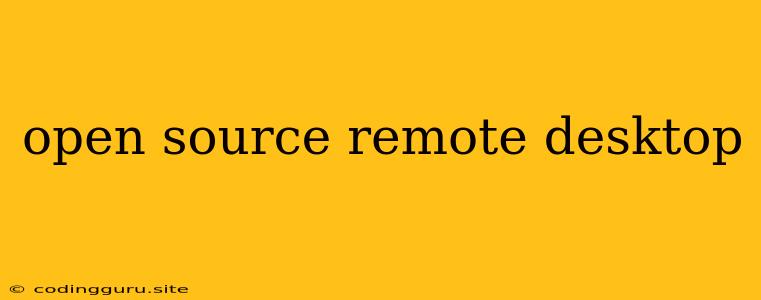Open Source Remote Desktop: A Comprehensive Guide
Remotely accessing another computer is a necessity for many users, whether for work, personal use, or system administration. While commercial solutions exist, there are numerous open source remote desktop options available, offering flexibility, customizability, and often, a cost-effective solution. This guide will delve into the world of open source remote desktop software, exploring its benefits, key features, and popular applications.
What is Open Source Remote Desktop?
Open source remote desktop software allows users to control a remote computer's desktop environment over a network connection. Unlike proprietary solutions, the source code for open source remote desktop applications is publicly available, meaning anyone can inspect, modify, and distribute it freely.
Advantages of Open Source Remote Desktop
Open source remote desktop software offers several advantages:
- Free of Charge: Users can download and use these applications without any licensing fees.
- Transparency and Customization: Accessing the source code allows for transparency and the ability to customize the software to meet specific needs.
- Community Support: Active communities contribute to the development and maintenance of open source remote desktop solutions, providing extensive support and resources.
- Security: While security concerns are present in any software, the open-source model allows for a more thorough scrutiny of code, potentially leading to better security practices.
Popular Open Source Remote Desktop Applications
Open source remote desktop software comes in various flavors, each with unique strengths and features. Here are a few popular options:
- **** NoMachine: This cross-platform solution offers excellent performance and supports a variety of protocols. It's known for its intuitive interface and ability to handle high-resolution displays effectively.
- **** TightVNC: A classic remote desktop application known for its simplicity and reliability. It provides a basic, yet efficient, way to control remote computers.
- **** Remote Desktop Connection (RDP) with FreeRDP: While not strictly "open source," FreeRDP is an open-source implementation of the Microsoft Remote Desktop Protocol (RDP). This allows users to connect to Windows computers remotely, providing a free alternative to Microsoft's proprietary solution.
- **** TeamViewer: While technically a commercial product, TeamViewer offers a free version for personal use, making it a viable option for basic remote desktop needs.
Choosing the Right Open Source Remote Desktop Solution
The choice of the best open source remote desktop solution depends on individual requirements. Here are some factors to consider:
- Operating System Compatibility: Ensure the application supports the operating systems you need to access or control.
- Performance Requirements: Some solutions offer better performance than others, especially for resource-intensive tasks or high-resolution displays.
- Security Considerations: Choose a solution that provides appropriate security features for your needs, such as encryption and password protection.
- Ease of Use: Consider the user interface and how easy it is to set up and use the application.
Tips for Using Open Source Remote Desktop Software
- Secure Your Connection: Always use a strong password and enable encryption to protect your data during remote sessions.
- Update Regularly: Keep your open source remote desktop software up to date to benefit from security patches and bug fixes.
- Test Connections: Before using a remote desktop application in a critical scenario, test the connection to ensure it works as expected.
- Understand the Limitations: Be aware of potential performance limitations and compatibility issues when using open source remote desktop software.
Conclusion
Open source remote desktop software offers a powerful and flexible solution for accessing and controlling remote computers. It provides numerous advantages, including cost-effectiveness, transparency, and community support. By carefully evaluating the available options and understanding their features, you can choose the open source remote desktop application that best suits your needs and preferences.
